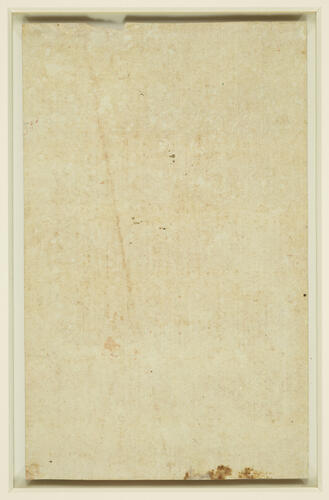-
1 of 253523 objects
A standing male nude c.1504-6
Red chalk, pen and ink on pale red prepared paper | 23.6 x 14.6 cm (sheet of paper) | RCIN 912594
-
A study of a nude man standing facing the spectator, with his legs apart and his arms hanging down at his sides. In his left hand he holds a stick. Melzi's number 61.
Leonardo’s most ambitious painting was the Battle of Anghiari, a huge mural commissioned in 1503 by the Florentine government for the Great Council Chamber of the Palazzo della Signoria. The mural remained unfinished when Leonardo was called back to Milan in 1506 and was obliterated 50 years later. Leonardo prepared meticulously for the project, studying male nudes systematically from front, back and side, to allow him to paint the monumental figures in the mural with complete confidence. Here the model spreads his legs evenly to balance his weight distribution: Leonardo combines subjective beauty with objective study of the underlying structures.
The nude studies were not directly preparatory for the Battle of Anghiari, but constituted background research on the human form. Here the model spread his legs equally to balance his weight distribution, and supported his arms by holding sticks so as to put no strain on the shoulder muscles. The drawings were studies in contour as well as surface modelling, and Leonardo went over the outlines of this drawing with pen and ink. This may have been made necessary by the choice of red prepared paper for red chalk drawings, which limited the tonal range available.
The drawing seems to have enjoyed some celebrity in later sixteenth-century Milan. It was reproduced on the title page of Rabisch dra Academiglia dor Compa Zavargna, Nabad dra Vall d'Bregn (1589), a compendium of mock-serious writings in a contrived dialect by Gianpaolo Lomazzo (Compa Zavargna), in his capacity as abbot (Nabad) of the Accademia del Val di Blenio; and a copy of the drawing, also at Windsor (912595), with the addition of a beard, may indeed be by Lomazzo.
Text adapted from M. Clayton, Leonardo da Vinci: The Divine and the Grotesque, London 2002Provenance
Bequeathed to Francesco Melzi; from whose heirs purchased by Pompeo Leoni, c.1582-90; Thomas Howard, 14th Earl of Arundel, by 1630; probably acquired by Charles II; Royal Collection by 1690
-
Creator(s)
Acquirer(s)
-
Medium and techniques
Red chalk, pen and ink on pale red prepared paper
Measurements
23.6 x 14.6 cm (sheet of paper)
Category
Object type(s)
Other number(s)
RL 12594
